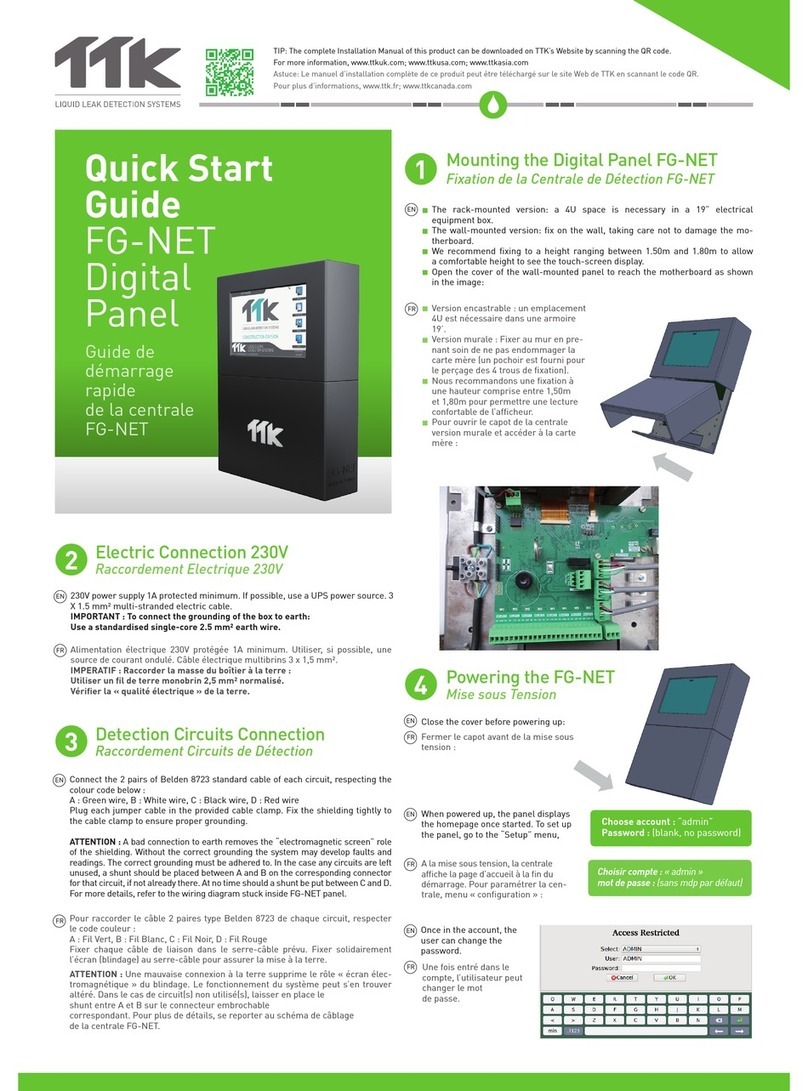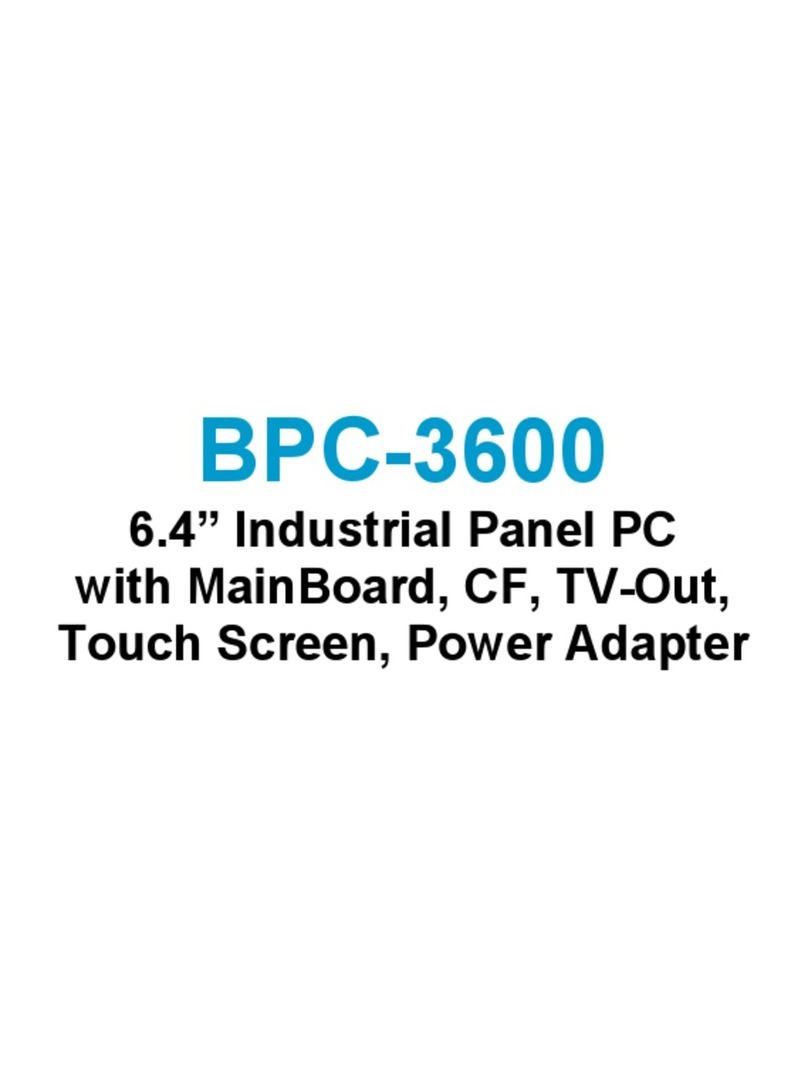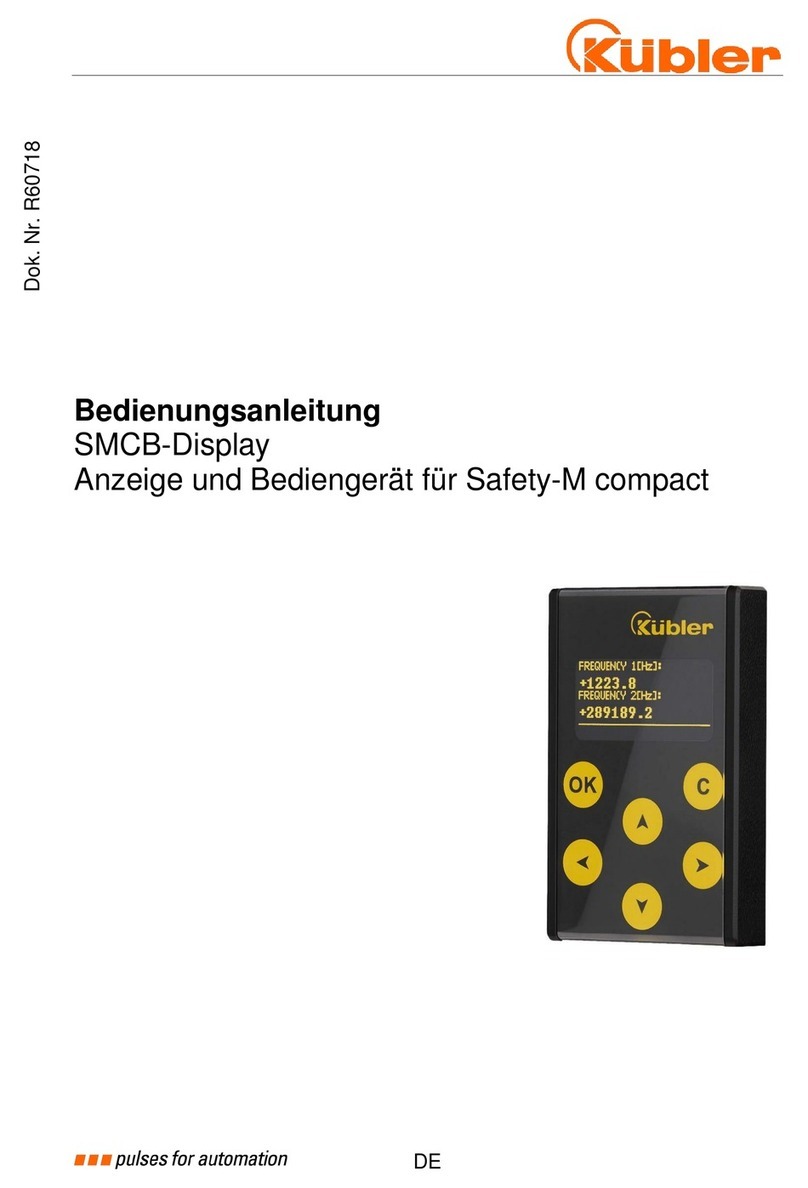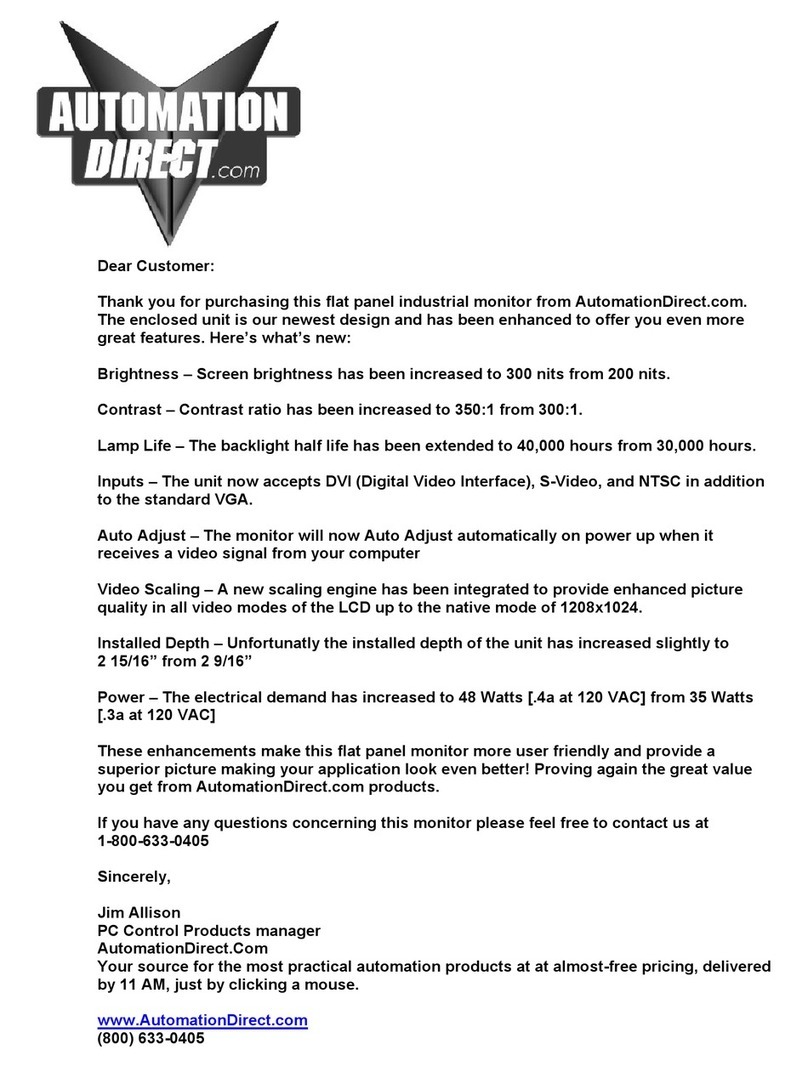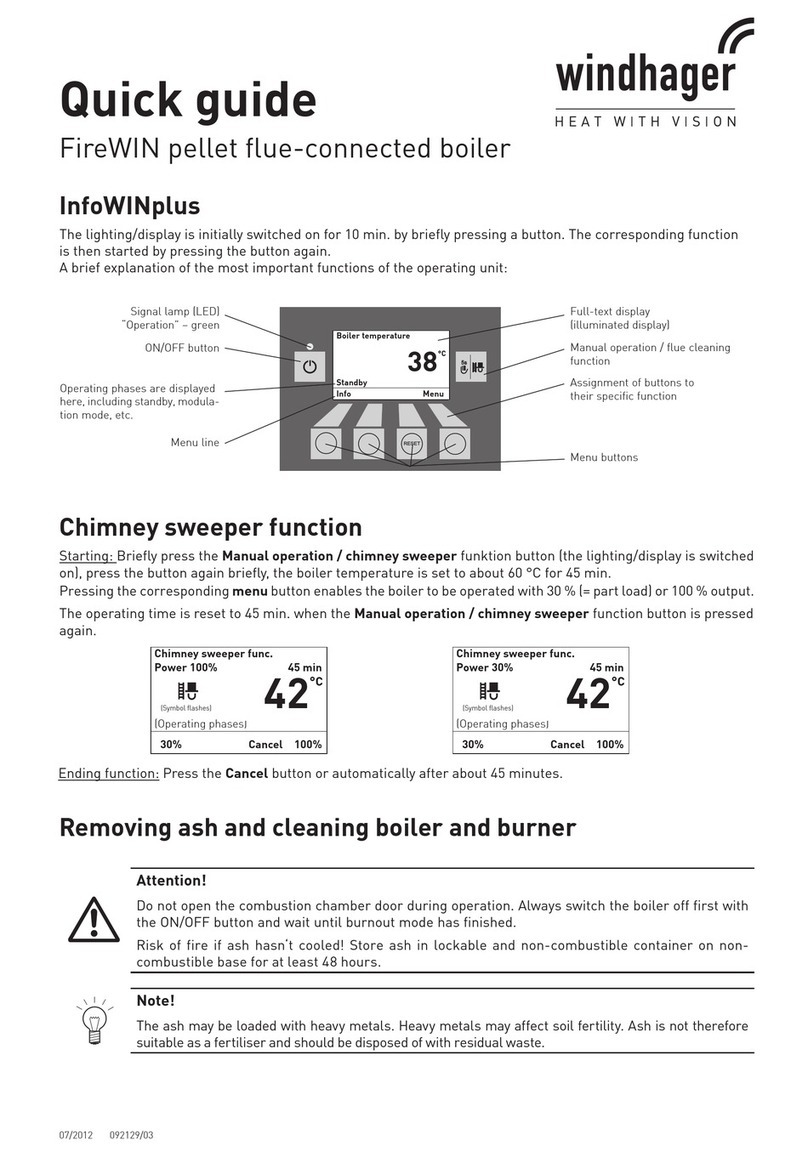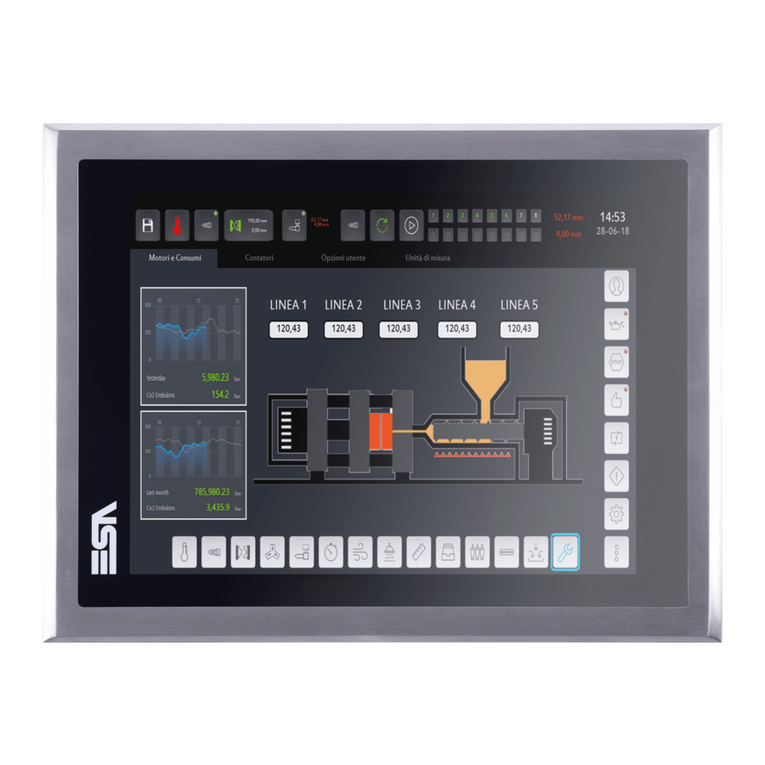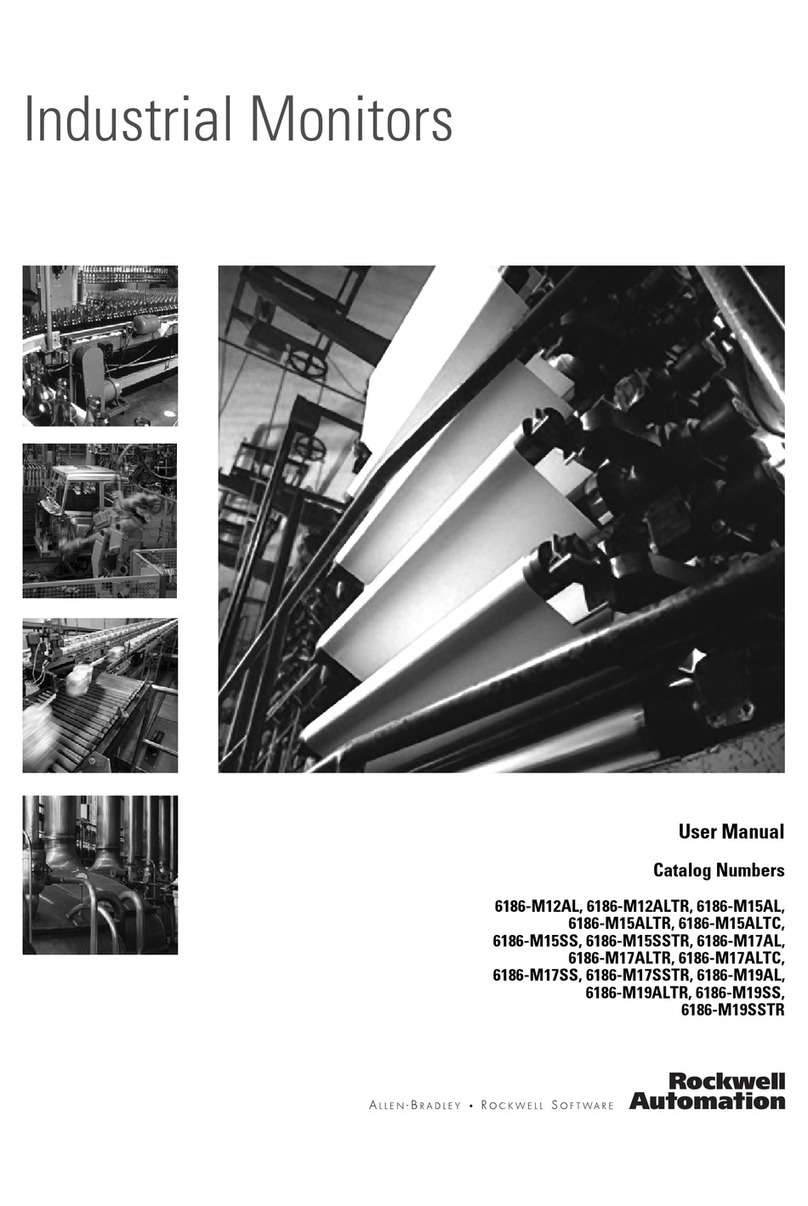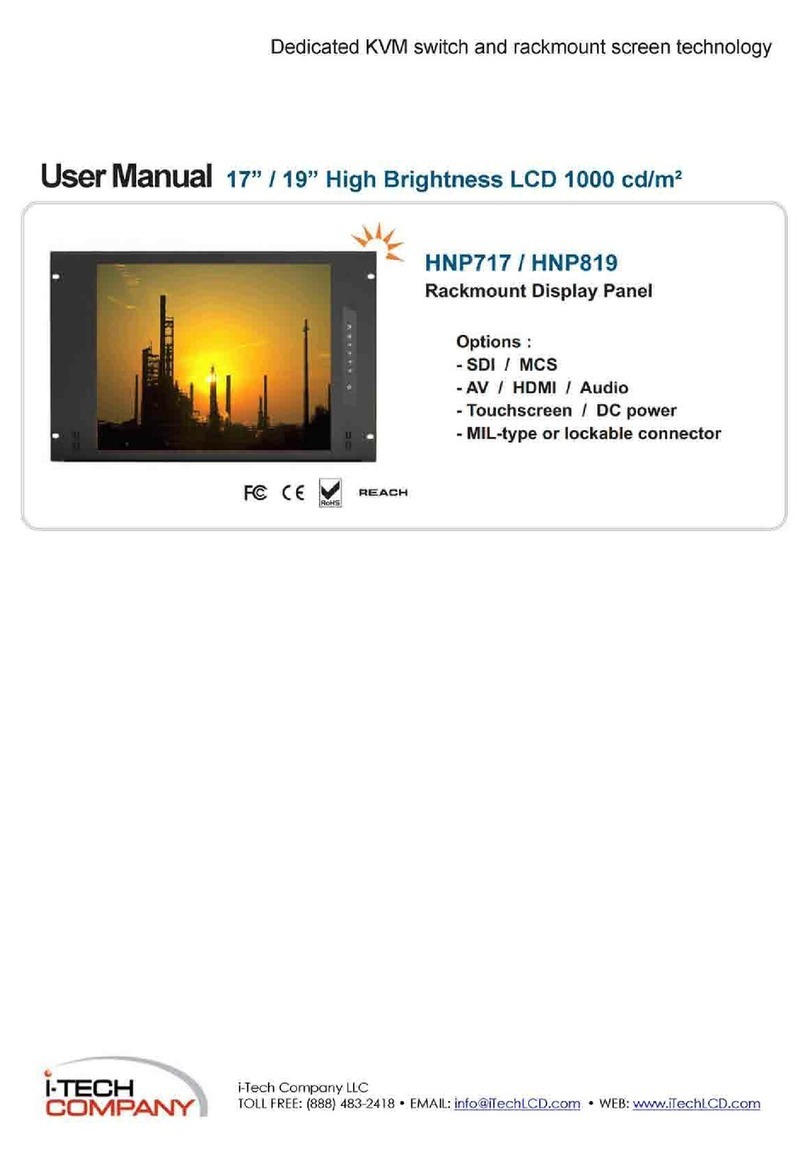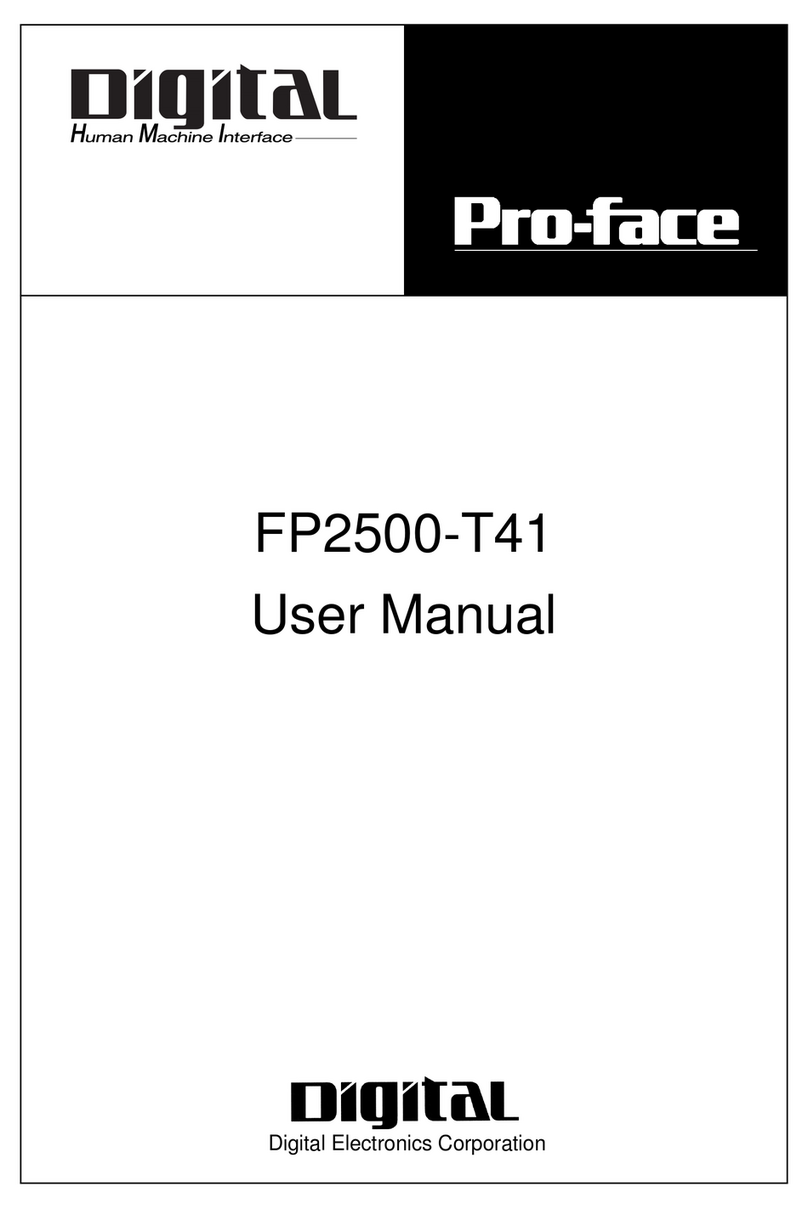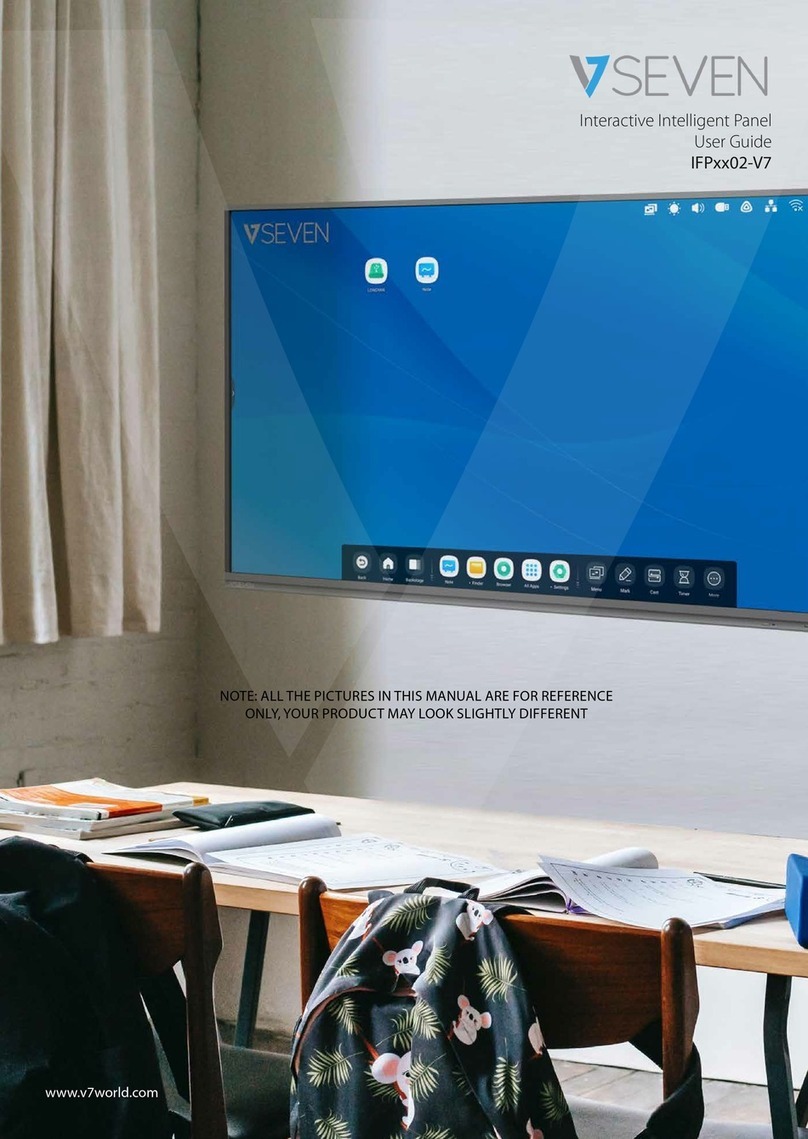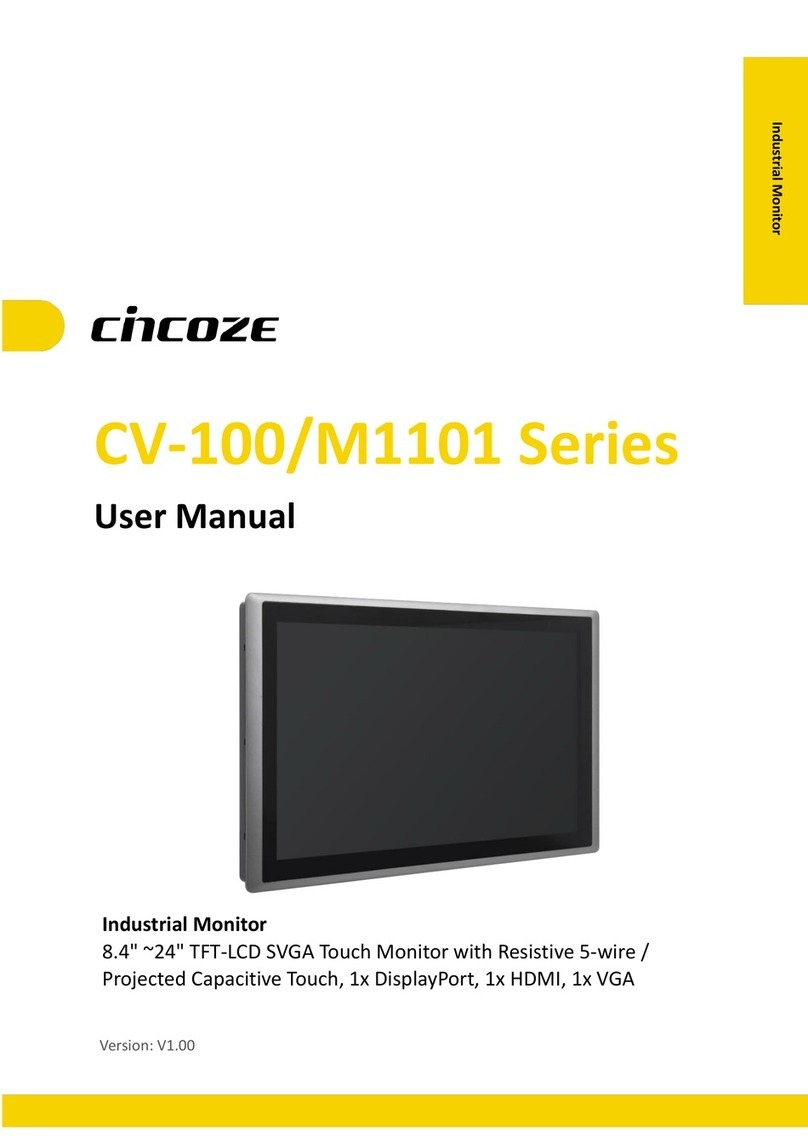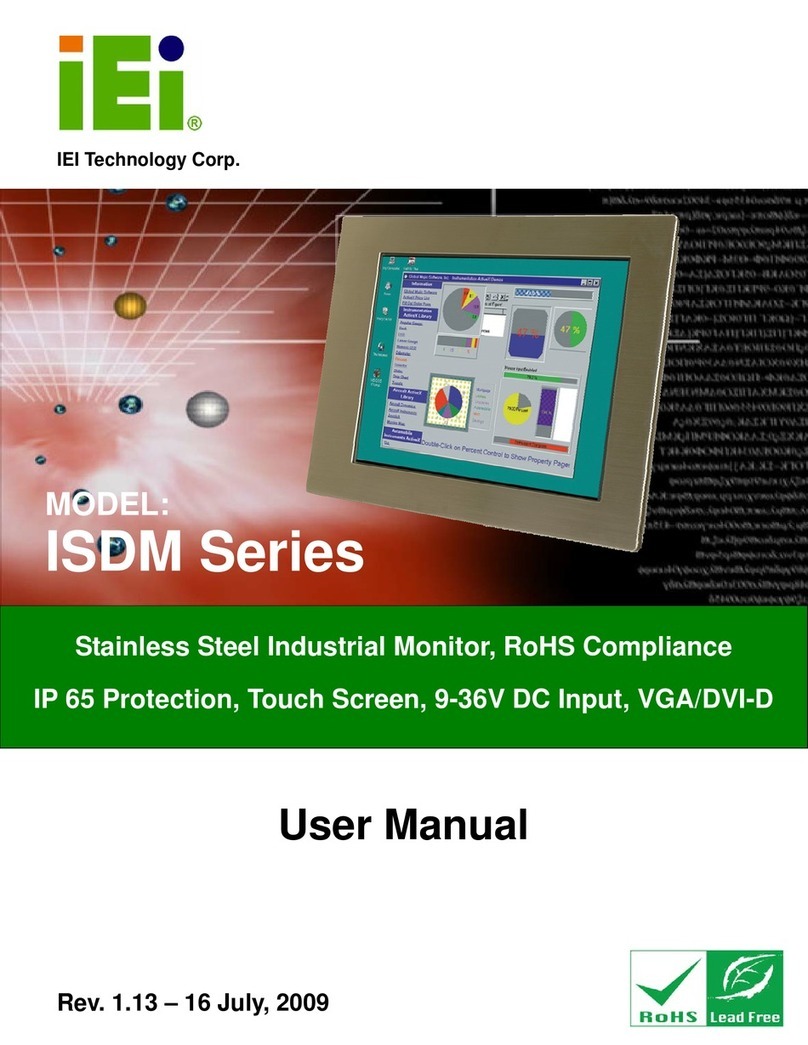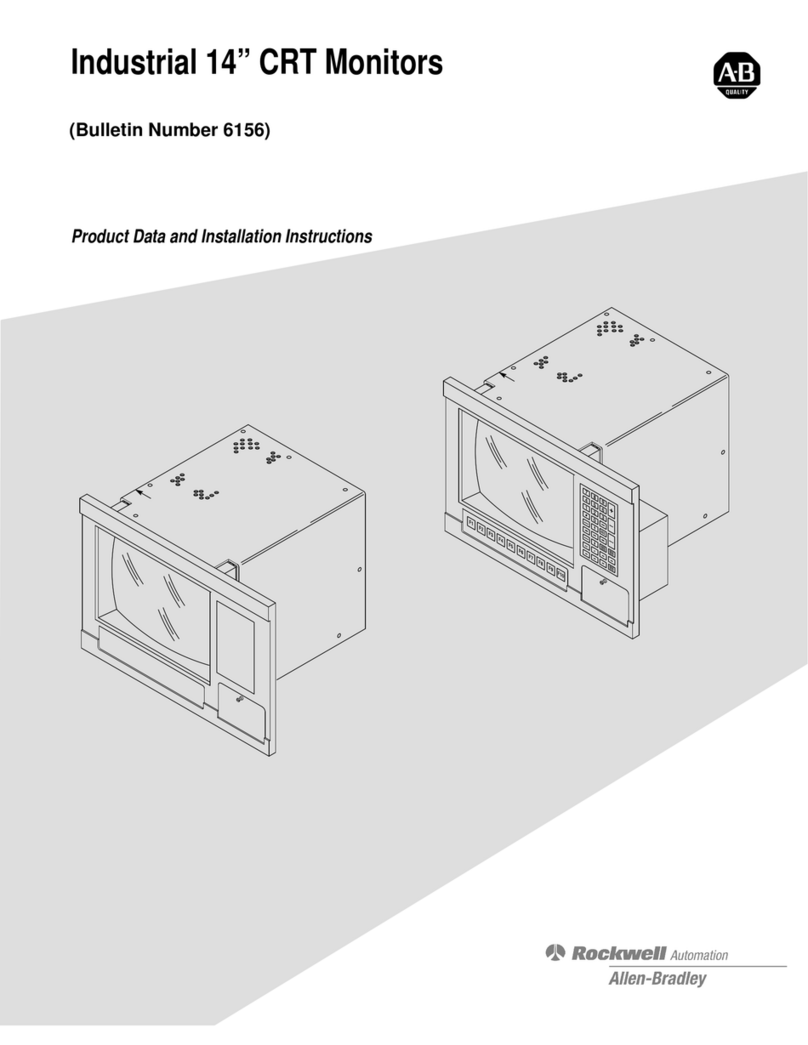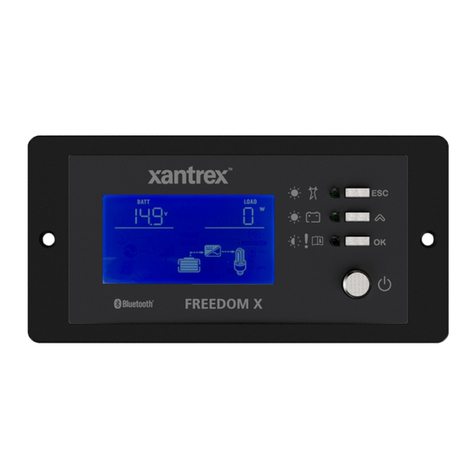Bitronics M870D User manual

M870D
Remote Display Manual
October 28, 2013
ML0027 Document Revision E
© 2013 by Bitronics, LLC

ML0027 October 28, 2013 Copyright 2013 Bitronics, LLC
ii
TABLE OF CONTENTS
M870D FIRMWARE REVISIONS...................................................................................iii
70 SERIES MANUAL SET.............................................................................................iii
INSTALLATION AND MAINTENANCE.........................................................................iv
WARRANTY AND ASSISTANCE..................................................................................iv
Authorized representative in the European Union.....................................................v
COPYRIGHT NOTICE.....................................................................................................v
TRADEMARKS...............................................................................................................v
SAFETY SECTION .......................................................................................................vii
1.0 Introduction ............................................................................................................1
1.1 Features ..................................................................................................................................................1
1.2 Specifications ..........................................................................................................................................1
1.3 Environmental .........................................................................................................................................1
1.4 Physical...................................................................................................................................................2
1.5 Standards and Certifications...................................................................................................................3
2.0 Installation ..............................................................................................................5
2.1 Initial Inspection.......................................................................................................................................5
2.2 Instrument Mounting................................................................................................................................5
2.3 Surge Protection......................................................................................................................................6
2.4 Overcurrent Protection............................................................................................................................6
2.5 Supply/Mains Disconnect........................................................................................................................6
2.6 Power Supply Connections.....................................................................................................................7
2.7 Cleaning ..................................................................................................................................................7
3.0 SETUP .....................................................................................................................8
3.1 Communications Connections.................................................................................................................8
3.2 Setup Mode...........................................................................................................................................10
3.3 Measurement Screens ..........................................................................................................................11
3.4 Operation...............................................................................................................................................13
3.4.1 Overview.........................................................................................................................................13
3.4.2 Keypad............................................................................................................................................14
3.4.3 Tx/Rx LED.......................................................................................................................................14
3.5 RS232 Service Port................................................................................................................................14
4.0 Troubleshooting....................................................................................................15
4.1 Error/Informational Messages................................................................................................................15
5.0 Firmware Upgrades...............................................................................................15

ML0027 October 28, 2013 Copyright 2013 Bitronics, LLC
iii
M870D FIRMWARE REVISIONS
Display Description Date
v1.01.0 Initial Release 4/23/02
v1.02.0 Update 7/25/02
v1.04.0 Update – Baud rate max 38400 11/01/02
v1.05.0 Update – Setup Config. saved to EEPROM 6/03/03
v1.06.0 Update – Bug fix 9/15/03
v1.07.0 Update – Changed bootup text to AREVA 3/05/04
v1.08.0 M570D release, power up sequence 10/07/05
Bootloader Description Date
v1.00.0 Initial Release 4/23/02
v1.01.0 Update 7/25/02
70 SERIES MANUAL SET
ML0021 M87X User Manual
ML0022 70 Series UCA®Object Model
ML0024 M87X Modbus Plus Module & Protocol
ML0025 70 Series Modbus Protocol
ML0026 70 Series DNP3 Protocol
ML0027 M870D Remote Display Manual
ML0032 M57X User Manual
ML0033 M570Dx Remote Display Manual
ML0034 70 Series IEC 61850 Protocol Manual
ML0041 878 DIOD User Manual

ML0027 October 28, 2013 Copyright 2013 Bitronics, LLC
iv
CERTIFICATION
Bitronics LLC certifies that the calibration of our products is based on measurements using
equipment whose calibration is traceable to the United States National Institute of Standards
Technology (NIST).
INSTALLATION AND MAINTENANCE
Bitronics LLC products are designed for ease of installation and maintenance. As with any product
of this nature, installation and maintenance can present electrical hazards and should be
performed only by properly trained and qualified personnel. If the equipment is used in a manner
not specified by Bitronics LLC, the protection provided by the equipment may be impaired.
In order to maintain UL recognition, the following Conditions of Acceptability shall apply:
a) Terminals and connectors that shall be connected to hazardous live voltages are restricted to
non-field wiring applications only.
b) After installation, all hazardous live parts shall be protected from contact by personnel or
enclosed in a suitable enclosure.
WARRANTY AND ASSISTANCE
This product is warranted against defects in materials and workmanship for a period of one
hundred and twenty (120) months from the date of their original shipment from the factory.
Products repaired at the factory are likewise warranted for eighteen (18) months from the date the
repaired product is shipped, or for the remainder of the product's original warranty, whichever is
greater. Obligation under this warranty is limited to repairing or replacing, at our designated
facility, any part or parts that our examination shows to be defective. Warranties only apply to
products subject to normal use and service. There are no warranties, obligations, liabilities for
consequential damages, or other liabilities on the part of Bitronics LLC except this warranty
covering the repair of defective materials. The warranties of merchantability and fitness for a
particular purpose are expressly excluded.
For assistance, contact Bitronics LLC at:
Telephone: 610.997.5100
Fax: 610.997.5450
Email: bitr[email protected]
Website: www.novatechweb.com/bitronics
Shipping:
261 Brodhead Road
Bethlehem, PA 18017-8698
USA

ML0027 October 28, 2013 Copyright 2013 Bitronics, LLC
v
AUTHORIZED REPRESENTATIVE IN THE EUROPEAN UNION
NovaTech Europe BVBA
Kontichsesteenweg 71
2630 Aartselaar
Belgium
T+32.3.458.0807
F+32.3.458.1817
COPYRIGHT NOTICE
This manual is copyrighted and all rights are reserved. The distribution and sale of this manual is
intended for the use of the original purchaser or his agents. This document may not, in whole or
part, be copied, photocopied, reproduced, translated or reduced to any electronic medium or
machine-readable form without prior consent of Bitronics LLC, except for use by the original
purchaser.
The product described by this manual contains hardware and software that is protected by
copyrights owned by one or more of the following entities:
Bitronics LLC, 261 Brodhead Road, Bethlehem, PA 18017;
VentureCom, Inc., Five Cambridge Center, Cambridge, MA 02142;
SISCO, Inc., 6605 192 Mile Road, Sterling Heights, MI 48314-1408;
General Software, Inc., Box 2571, Redmond, WA 98073;
Schneider Automation, Inc., One High Street, North Andover, MA 01845;
Triangle MicroWorks, Inc., 2213 Middlefield Court, Raleigh, NC 27615
Greenleaf Software Inc., Brandywine Place, Suite 100, 710 East Park Blvd, Plano, TX 75074
TRADEMARKS
The following are trademarks or registered trademarks of Bitronics LLC:
The Bitronics logo Bitronics PowerPlex Triplex Triple-II
MultiComm PowerServe SubCycle TechnologySubCycleStuf
The following are trademarks or registered trademarks of AREVA T&D Inc.
AREVA T&D the AREVA logo MiCOM
The following are trademarks or registered trademarks of the DNP User's Group:
DNP DNP3
The following are trademarks or registered trademarks of the Electric Power Research Institute
(EPRI):
UCA
The following are trademarks or registered trademarks of Schneider Automation, Inc.:
MODSOFT Modicon Modbus Plus Modbus Compact 984 PLC

ML0027 October 28, 2013 Copyright 2013 Bitronics, LLC
vi
The following are trademarks or registered trademarks of VentureCom, Inc.:
Phar Lap the Phar Lap logo
The following are trademarks or registered trademarks of Systems Integration Specialists
Company, Inc. (SISCO):
SISCO MMS-EASE Lite AX-S4MMS
The following are trademarks or registered trademarks of General Software, Inc.:
General Software the GS logo EMBEDDED BIOS Embedded DOS
The following are trademarks or registered trademarks of the PCI Industrial Computer
Manufacturers Group:
CompactPCI PICMG the CompactPCI logo the PICMG logo

ML0027 October 28, 2013 Copyright 2013 Bitronics, LLC
vii
SAFETY SECTION
This Safety Section should be read before commencing any work on the equipment.
Health and safety
The information in the Safety Section of the product documentation is intended to ensure that
products are properly installed and handled in order to maintain them in a safe condition. It is
assumed that everyone who will be associated with the equipment will be familiar with the contents
of the Safety Section.
Explanation of symbols and labels
The meaning of symbols and labels that may be used on the equipment or in the product
documentation is given below.
Installing, Commissioning and Servicing
Equipment connections
Personnel undertaking installation, commissioning or servicing work on this equipment should be
aware of the correct working procedures to ensure safety. The product documentation should be
consulted before installing, commissioning or servicing the equipment.
Terminals exposed during installation, commissioning and maintenance may present a hazardous
voltage unless the equipment is electrically isolated.

ML0027 October 28, 2013 Copyright 2013 Bitronics, LLC
viii
If there is unlocked access to the equipment, care should be taken by all personnel to avoid
electric shock or energy hazards.
Voltage and current connections should be made using insulated crimp terminations to ensure that
terminal block insulation requirements are maintained for safety. To ensure that wires are correctly
terminated, the correct crimp terminal and tool for the wire size should be used.
Before energizing the equipment, it must be grounded (earthed) using the protective ground (earth)
terminal, or the appropriate termination of the supply plug in the case of plug connected
equipment. Omitting or disconnecting the equipment ground (earth) may cause a safety hazard.
The recommended minimum ground (earth) wire size is 2.5 mm2 (#12 AWG), unless otherwise
stated in the technical data section of the product documentation.
Before energizing the equipment, the following should be checked:
1. Voltage rating and polarity
2. CT circuit rating and integrity of connections
3. Protective fuse rating
4. Integrity of ground (earth) connection (where applicable)
5. Equipment operating conditions
The equipment should be operated within the specified electrical and environmental limits.
Current transformer circuits
Do not open the secondary circuit of a live CT since the high voltage produced may be lethal to
personnel and could damage insulation.
External resistors
Where external resistors are fitted to relays, these may present a risk of electric shock or burns, if
touched.
Battery replacement
Where internal batteries are fitted, they should be replaced with the recommended type and be
installed with the correct polarity, to avoid possible damage to the equipment.
Insulation and dielectric strength testing
Insulation testing may leave capacitors charged up to a hazardous voltage. At the end of each part
of the test, the voltage should be gradually reduced to zero, to discharge capacitors, before the test
leads are disconnected.

ML0027 October 28, 2013 Copyright 2013 Bitronics, LLC
ix
WARNING: EMISSIONS - CLASS A DEVICE (N55011)
This is a Class A industrial device. Operation of this device in a residential area may cause
harmful interference, which may require the user to take adequate measures.
DECOMMISSIONING AND DISPOSAL
1. Decommissioning
The auxiliary supply circuit in the relay may include capacitors across the supply or to
ground (earth). To avoid electric shock or energy hazards, after completely isolating the
supplies to the relay (both poles of any dc supply), the capacitors should be safely
discharged via the external terminals before decommissioning.
2. Disposal
It is recommended that incineration and disposal to watercourses is avoided. The product
should be disposed of in a safe manner. Any products containing batteries should have
them removed before disposal, taking precautions to avoid short circuits. Particular
regulations within the country of operation may apply to the disposal of lithium batteries.

ML0027 October 28, 2013 Copyright 2013 Bitronics, LLC
1
1.0 INTRODUCTION
The M870D Remote Display connects to 70 Series IEDs through one of the serial communications
ports. The M870D is designed to provide a convenient way to view measurements made by the 70
Series IEDs. A maximum of 64 user-configurable measurement screens can be displayed. The
instrument can be set to display a single screen continually or automatically scroll through all
available screens. Additionally, the user may manually step through all available screens. All of
the screens can be scrolled.
1.1 Features
Rugged Bitronics design
Bright LED display, 3 lines of 5 digits and a one line, 8 character alphanumeric
Standard 4” round mounting
Configurable RS232 or RS485 communication
PC based configuration tool for quick setup
Front panel service port
Front panel Demand and Energy reset (if enabled)
1.2 Specifications
Display: 3 lines of 5 digits, Red LED, 0.56” High
1 line by 8 character alphanumeric, Red LED, 0.11” High
User Interface: 4 pushbuttons
Communication: Selectable RS232 or RS485 (4-wire), full duplex
9600, 19200, or 38400 baud
8 bit, No parity, 1 stop bit
Distance: 50 ft. (15m) RS232, 4000 ft. (1200m) RS485
Addressability: Display Addresses 1 .. 15
Power Supply Requirements:
Nominal: 24-250Vdc, 69-240Vac (50/60Hz)
Operating Range: 20-300Vdc, 55-275Vac (45-65Hz)
Burden: 11VA max, 4W max
Weight (typical) : 1.25 lbs (0.57 kg)
1.3 Environmental
Operating Temperature: -40 to 70degC
Humidity: 0-95% non-condensing
Installation Category: IC III (Distribution Level), Pollution Degree 2

ML0027 October 28, 2013 Copyright 2013 Bitronics, LLC
2
(See Definitions, page 2)
Enclosure Protection: IP52 – Front Panel, IP20 – Rear (to IEC 60529: 1989). Ratings are
applicable for enclosure category 2 (see Definitions, below).
Altitude: Up to and including 2000m above sea level
Intended Use: Indoor; Indoor/Outdoor use when mounted in an appropriately rated
protective enclosure to NEMA or IP protection classifications, as
required for the installation.
1.4 Physical
Connections: 3 pin removable terminal block for power inputs, accepts 26-12AWG
wire (0.15-3.3mm2), or terminal lugs up to 0.325” (8.25mm) wide.
Recommended minimum wire size is #18 AWG (0.5mm2).
Recommended torque rating for the terminal block wire fasteners is
10 in-lbs (1.13N-m). Precautions must be taken to prevent shorting
of lugs at the terminal block. A minimum distance of 0.1" (2.5mm) is
recommended between un-insulated lugs to maintain insulation
requirements.
Standard 0.200” (5.08mm) header socket accepts other standard
terminal types.
6 pin removable terminal block for communications, accepts 26-
12AWG wire. Standard 0.200” (5.08mm) header socket accepts
other standard terminal types. The recommended torque rating for
the terminal block wire fasteners is 4.4 in-lbs (0.5N-m).
Standard 9 pin RS232 for service port
Package: 4.5” square faceplate requires 4” round cutout for mounting.
Definitions:
Enclosure Category 2: Enclosures where no pressure difference relative to the surrounding air is
present.
Installation Category (Overvoltage Category) III: Distribution Level, fixed installation, with
smaller transient overvoltages than those at the primary supply level, overhead lines, cable
systems, etc.
Pollution: Any degree of foreign matter, solid, liquid, or gaseous that can result in a reduction of
electric strength or surface resistivity of the insulation.
Pollution Degree 2: Only non-conductive pollution occurs except that occasionally a temporary
conductivity caused by condensation is to be expected.

ML0027 October 28, 2013 Copyright 2013 Bitronics, LLC
3
1.5 Standards and Certifications
UL/CSA Recognized, File Number E164178
UL61010-1, Edition 3, 2012/05/11
CAN/ CSA No. 22.2 No. 61010-1-12, 2012/05/01
If applicable, the CE mark must be prominently marked on the case label.
European Community Directive on EMC 2004/108/EC, (replaced former directive
89/336/EEC amended by 92/31/EEC, 93/68/EEC, 98/13/EC
European Community Directive on Low Voltage 2006/95/EC (replaces former directive
73/23/EEC amended by 93/68/EEC)
Product and Generic Standards
The following generic standards were used to establish conformity:
Low Voltage (Product Safety): IEC 61010-1, Edition 3, 2013/02/01
EMC: EN 61326-1: 2006, EN 61000-6-2: 2005, EN 61000-6-4 : 2007 (EN 50081-2: 1993 has been
superseded).
Radiated Emissions Electric Field Strength
EN 55011: 2007 / A2: 2007 (supersedes EN 55011: 1998 / A1:1999)
Group 1, Class A
Frequency: 30 - 1000 MHz
AC Powerline Conducted Emissions
EN 55011: 2007 / A2: 2007 (supersedes EN 55011: 1998 / A1:1999)
Group 1, Class A
Frequency: 150 kHz – 30 MHz
Electrostatic Discharge (ESD)
EN 61000-4-2: 1995 / A1: 1998: / A2: 2001
Discharge voltage: ± 8 KV Air; ± 4 KV Contact
Immunity to Radiated Electromagnetic Energy (Radio Frequency)
EN 61000-4-3: 2006 / A1: 2008 Class III (supersedes EN 61000-4-3: 2002 &
EN61000-4-3: 2002 / A1:2002; and ENV 50204: 1996, on Immunity to Radiated Electromagnetic
Energy -Digital Radio Telephones, 900MHz & 1890MHz).
Frequency: 80 - 1000 MHz Amplitude: 10.0 V/m Modulation: 80% AM @ 1 kHz
Frequency: 1400 - 2000 MHzAmplitude: 3.0 V/m Modulation: 80% AM @ 1 kHz
Frequency: 2000 - 2700 MHzAmplitude: 1.0 V/m Modulation: 80% AM @ 1 kHz
Electrical Fast Transient / Burst Immunity
EN 61000-4-4: 2004 (supersedes EN 61000-4-4: 1995)
Burst Frequency: 5 kHz
Amplitude, AC Power Port ± 4 KV
Amplitude, Signal Port: ± 2 KV
Current/Voltage Surge Immunity
EN 61000-4-5: 2006 (supersedes EN 61000-4-5: 1995)
Open Circuit Voltage: 1.2 / 50 µs
Short Circuit Current: 8 / 20 µs
Amplitude, AC Power Port: 2 KV common mode, 1 KV differential mode
Amplitude, I/O Signal Port: 1 KV common mode

ML0027 October 28, 2013 Copyright 2013 Bitronics, LLC
4
Immunity to Conducted Disturbances Induced by Radio Frequency Fields
EN 61000-4-6: 2007 (supersedes EN 61000-4-6: 1996)
Level: 3
Frequency: 150 kHz – 80 MHz
Amplitude: 10 V rms
Modulation: 80% AM @ 1 kHz
AC Supply Voltage Dips and Short Interruptions
EN 61000-4-11: 2004 (supersedes EN 61000-4-11: 1994)

ML0027 October 28, 2013 Copyright 2013 Bitronics, LLC
5
2.0 INSTALLATION
WARNING - INSTALLATION AND MAINTENANCE SHOULD ONLY BE PERFORMED BY
PROPERLY TRAINED OR QUALIFIED PERSONNEL.
2.1 Initial Inspection
Bitronics instruments are carefully checked and "burned in" at the factory before shipment.
Damages can occur, however, so please check the instrument for shipping damage as it is
unpacked. Notify Bitronics LLC immediately if any damage has occurred, and save any damaged
shipping containers.
2.2 Instrument Mounting
The instrument may be mounted on a 19" Rack panel if desired. Three units will fit side by side on
a standard 5.25" high panel. See Figure 2 for panel cutout dimensions. The unit should be
mounted using the four #10-32 studs attached to the flanges. Make sure that any paint or other
coatings on the panel do not prevent electrical contact.
Figure 1 – Instrument Dimensions

ML0027 October 28, 2013 Copyright 2013 Bitronics, LLC
6
Figure 2 - Panel Cutout Dimensions
2.3 Surge Protection
Surge protection devices are incorporated into the power supply. The mounting flange is a safety
ground for the instrument, and must be connected to a protective ground (earth) circuit. If the unit
is powered from a VT, it is recommended that one side of the VT be grounded at the instrument
following ANSI/IEEE C57.13.3-1983. See Section 2.4 for fuse recommendations.
2.4 Overcurrent Protection
To maintain the safety features of this product, a 2 Ampere time delay (T) fuse, with a minimum
interrupting rating of 1500 Amperes, must be connected in series with the ungrounded/non-earthed
(hot) side of the supply input prior to installation. The fuse must carry a voltage rating appropriate
for the power system on which it is to be used. A UL Recognized fuse in an appropriate fuse
holder should be used in order to maintain UL product approval.
2.5 Supply/Mains Disconnect
Equipment shall be provided with a Supply/Mains Disconnect that can be actuated by the operator
and simultaneously open both sides of the mains input line. The disconnect should be UL

ML0027 October 28, 2013 Copyright 2013 Bitronics, LLC
7
recognized in order to maintain any UL product approval. The Disconnect should be acceptable
for the application and adequately rated for the equipment.
2.6 Power Supply Connections
Power and ground are applied to three screws on a barrier strip on the rear of the M870D. There
is one chassis ground point that MUST be connected to Earth Ground. This is located on the
mounting flange. Connection of the chassis ground is required, see Section 2.3. Bitronics
recommends that all grounding be performed in accordance with ANSI/IEEE C57.13.3-1983.
2.7 Cleaning
Cleaning the exterior of the instrument shall be limited to the wiping of the instrument using a soft
damp cloth applicator with cleaning agents that are not alcohol based, and are non-flammable,
non-explosive.

ML0027 October 28, 2013 Copyright 2013 Bitronics, LLC
8
3.0 SETUP
3.1 Communications Connections

ML0027 October 28, 2013 Copyright 2013 Bitronics, LLC
9
M870D RS-232 Cable Connections to the M57x

ML0027 October 28, 2013 Copyright 2013 Bitronics, LLC
10
3.2 Setup Mode
The M870D has three configurable parameters that must be set to match the device to which it is
connected. Press the up arrow key and the right arrow key simultaneously to enter the display
setup mode. The alphanumeric display will describe the selected parameter, while the digit display
will show the value. Use the up and down arrow keys to scroll through the available values for that
parameter. When the desired value is displayed, press the right arrow button to confirm the
setting. The left arrow button is used to go to the next configurable parameter. When ‘Exit’
appears in the alphanumeric display, press the right arrow key to return to normal operation. The
instrument will automatically return to normal operation if no keys have been pressed in
approximately 20 seconds. This timeout prevents the instrument from inadvertently being left in
setup mode.
The settings for Meter ID, Baud and Mode must match the corresponding settings of the M870
series instrument to which it is connected. Factory defaults for the parameters are: Meter ID = 1,
Baud = 9600, Mode = 232
Parameter
Available Values
Meter ID
1 – 15
Baud
9600,19200, 38400 Baud
Mode
232, 485
Version
Displays current version information. This value cannot be modified.
Exit
Allows exiting setup mode.
Table 1 – Configurable Parameters

ML0027 October 28, 2013 Copyright 2013 Bitronics, LLC
11
WARNING - THE METER ADDRESS, COMMUNICATION MODE, AND BAUD RATE
PARAMETERS ARE STORED IN NON-VOLATILE MEMORY. THIS MEMORY
STORAGE HAS A 1,000,000 CYCLE ENDURANCE RATING. (PARAMETERS CAN BE
CHANGED 1,000,000 TIMES).
Note: Instruments produced prior to July, 2002 will display a ‘Remove Power!’ message when the
hardware setup has been changed. If this message is displayed, remove the input power to the
instrument for a few seconds and then reapply power. The instrument will go through its normal
boot sequence and the new settings will take effect.
3.3 Measurement Screens
Measurements that are shown on the M870D are setup using the Windowsbased 70 Series
Configurator. There are two folders in the Communication section, which must be configured
before the M870D can be used. The first folder is used to setup the Port Assignments, as shown
in Figure 3. Set the protocol of the port to which the Remote Display is connected to
Zmodem/Display/Log. Set the Media, Parity, and Baud settings as required. The RxD to TxD
parameter can be set to zero and the Run Display box must be checked. In this example, Port 1 is
set to run the display.
The Detached Display Folder must now be set up to show the proper measurements. Figure 4
shows the layout of this folder.
Figure 3 – Configurator Communication/Port Assignments Folder
Table of contents

